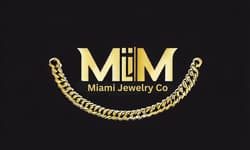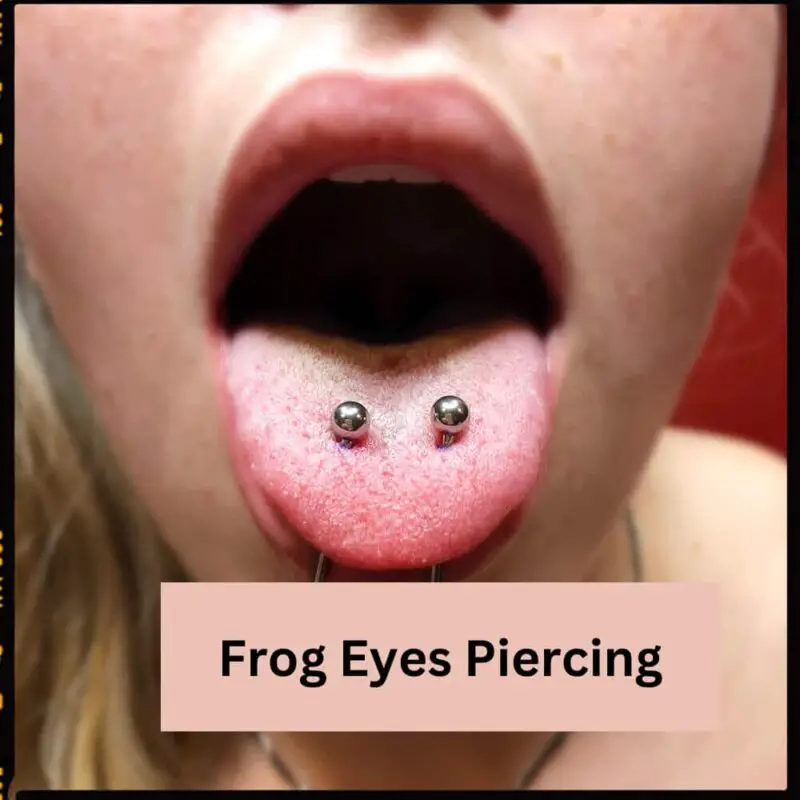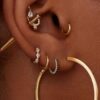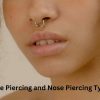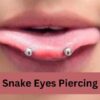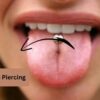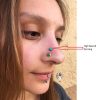Tongue Piercing
Frog Eyes Piercing: Pain, Cost, FAQs, Ideas & Aftercare Tips
Have you ever wondered what it would be like to have two small metal balls on your tongue, resembling the eyes of a frog?
Frog eyes piercing, also known as venom piercing, is a type of tongue piercing that involves two separate barbells placed on either side of the tongue, near the midline. The balls on the jewelry resemble the eyes of a frog when you open your mouth, hence the name1.
But before you hop on to the nearest piercing studio and get your tongue pierced, you should know that frog eyes piercing is not for the faint-hearted. It is a delicate and risky procedure that requires a skilled and experienced piercer. It also comes with a lot of pain, swelling, and potential complications.
This article will provide you with a comprehensive guide on everything you need to know about this piercing, including:
- The Process: How they are done.
- Maintenance Matters: How to clean and care for them.
- Healing Timelines: How long they take to heal.
- Brace for Impact: The pain factor.
- The Price Tag: Investment insights.
- After the Deed: Post-piercing care tips.
- Potential Pitfalls: The associated risks and complications.
- The Decision Balance: Pros and cons to weigh.
- Dazzling Decisions: Choosing the best jewelry, inclusive of materials and designs.
- Fashion Forward: Ways to style, switch, and showcase your Frog Eyes Piercing.
- Comparative Study: How it fares against other tongue piercings.
- All You Wondered: FAQ addressing all your concerns.
By the end of this article, you will have a better understanding of what frog eyes tongue piercing entails, and whether it is the right choice for you.
So, let’s get started!
Contents
- 1 What is Frog Eyes Piercings
- 2 Anatomy of a Frog Eyes Piercing
- 3 How Frog Eyes Piercing is Done
- 4 Frog Eyes Piercing Video Guide
- 5 How Long Does Frog Eyes Piercing Take to Heal?
- 6 How Much Does Frog Eyes Piercing Hurt?
- 7 How Much is Frog Eyes Piercing Cost?
- 8 Jewelry Choices for Frog Eyes Tongue Piercing
- 9 Risks and Complications of Frog Eyes Piercing
- 10 How to Avoid Complications
- 11 Healing Time and Aftercare Tips for Frog Eyes Tongue Piercing
- 12 Pros and Cons of Frog Eyes Piercing
- 13 Celebrity with Frog Eye Piercing
- 14 How to Style Frog Eye Piercing with Other Piercing:
- 15 FAQs
- 16 Conclusion
What is Frog Eyes Piercings
The FROG eyes piercing is characterized by two parallel piercings on the tongue, resembling the eyes of a frog. Unlike a central tongue stud, this is a dual puncture, providing a distinct look.
Anatomy of a Frog Eyes Piercing
The primary differentiation between a standard tongue piercing and the FROG eyes is the placement. While the former is typically a singular central puncture, the latter boasts two side-by-side piercings.
Technical Aspects
When discussing the FROG eyes piercing, a few terminologies are crucial:
Frenulum:
The tissue connecting the tongue’s base to the mouth’s floor, a critical consideration during the piercing to avoid complications.
Barbell:
A common jewelry type used for this piercing, is available in various materials like surgical steel or titanium.
How Frog Eyes Piercing is Done
Now that you have decided on the type and cost of your frog eyes piercing, you need to know what to expect during and after the procedure.
Here are the steps involved in getting frog eyes tongue piercing done by a professional piercer:
Consultation:
The first step is to consult with your piercer about your frog eyes piercing. Your piercer will ask you some questions about your medical history, allergies, medications, etc., to make sure that you are eligible and ready for the piercing
Marking:
The next step is to mark the spots where the piercings will be done. Your piercer will use a pen or a marker to draw two dots on your tongue, one on each side. You will be able to see the markings in a mirror and approve them before the piercing begins. You can also ask your piercer to adjust the markings if you are not satisfied with them.
Clamping:
The next step is to clamp your tongue with a special tool that holds it in place and prevents it from moving. This may feel uncomfortable or awkward, but it is necessary to ensure a precise and safe piercing. Your piercer will clamp your tongue near the tip, where the markings are.
Piercing:
The next step is to pierce your tongue with a hollow needle. Your piercer will insert the needle through one of the markings, from top to bottom, and then through the other one, from bottom to top. This way, the needle will create two holes on your tongue that are parallel to each other. You may feel a sharp pain or a pinch when the needle goes through your tongue, but it will be over quickly.
Jewelry insertion:
The next step is to insert the jewelry into your piercings. Your piercer will use a taper or a guide to push the jewelry through the holes created by the needle. You may feel some pressure or discomfort when the jewelry goes through your tongue, but it will be less painful than the piercing itself. Your piercer will then screw or snap the balls on the ends of the jewelry to secure it in place.
Cleaning:
The last step is to clean your piercings and your mouth. Your piercer will use a cotton swab or a gauze pad to wipe away any blood or saliva from your tongue and your jewelry. They will also give you a mouthwash or a saline solution to rinse your mouth and kill any bacteria that may cause infection. You should spit out the mouthwash or saline solution after rinsing, and avoid swallowing it.
That’s it! You have successfully completed your frog eyes tongue piercing procedure. Your piercer will give you some aftercare instructions and tips on how to take care of your new piercing. Make sure you follow them carefully and contact your piercer or a doctor if you have any questions or concerns.
Frog Eyes Piercing Video Guide
How Long Does Frog Eyes Piercing Take to Heal?
The healing duration of the FROG eyes tongue piercing largely depends on an individual’s overall health, aftercare routine, and possible complications. Generally, the initial healing phase, where the surface of the piercing begins to close, ranges from 4 to 6 weeks. Complete internal healing, where the entire puncture wound heals, can take anywhere from 6 months to a year. It’s crucial to follow the aftercare guidelines provided by your piercing professional to ensure a smooth and infection-free healing process.

How Much Does Frog Eyes Piercing Hurt?
Pain is subjective and varies from one individual to another based on their pain threshold. While tongue piercings are commonly associated with a sharp but quick pain, the FROG eyes piercing might entail a slightly longer duration of discomfort due to the double puncture. Again, the experience can vary, with some describing it as a strong pinch, while others might find it more intense. It’s essential to note that the pain usually subsides considerably after the initial piercing process, with occasional soreness during the initial days of healing.
How Much is Frog Eyes Piercing Cost?
Another thing you need to consider when getting frog eyes piercing is how much it will cost you. The cost of frog eyes tongue piercing depends on several factors, such as:
Location:
Prices might differ based on the geographical location and the cost of living in that area.
Popularity:
The cost of frog eyes tongue piercing may also depend on how popular or trendy it is. The more popular or trendy a piercing is, the more likely it is to be in high demand and have a higher price. For example, frog eyes tongue piercing may be more expensive than other types of tongue piercings, such as midline or snake eyes piercing, because it is more unique and uncommon.
Experience of the piercer:
Its cost also depend on the experience and reputation of the piercer who performs it. The more experienced and reputable a piercer is, the more likely they are to charge a higher price for their service. This is because they have more skills, knowledge, and equipment to ensure a safe and successful piercing. However, this also means that they can provide you with better quality and results.
Quality of the jewelry:
The choice of jewelry, from basic surgical steel to premium materials, can also impact the overall cost.
Given these factors, the average range of prices for frog eyes tongue piercing in different countries or regions are:
- USA: $50-$100 USD
- UK: £40-£80 GBP
- Canada: $60-$120 CAD
- Australia: $70-$140 AUD
- India: ₹3,000-₹6,000 INR
- China: ¥300-¥600 CNY
These prices are only estimates and may vary depending on the specific circumstances and preferences of each individual. You should always do your own research and compare different options before deciding on where and how to get your frog eyes piercing done.
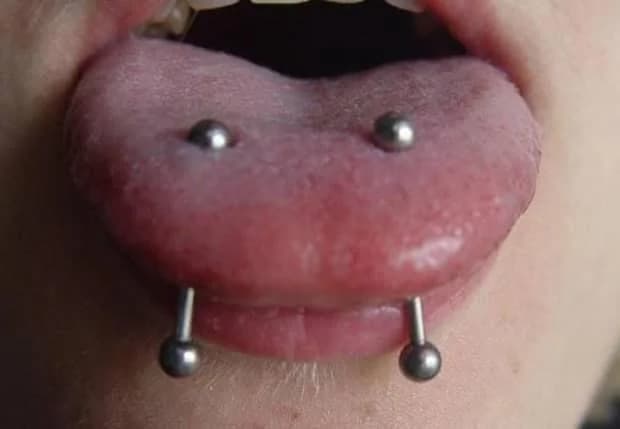
Jewelry Choices for Frog Eyes Tongue Piercing
One of the first things you need to consider when getting frog eyes tongue piercing is what kind of jewelry you want to wear. There are different types of jewelry that can be used for this piercing, each with its own pros and cons.
Here are some of the most common ones:
Straight barbells:
These are two metal rods with balls on both ends. They’re popular because:
- Easy to put in and take out
- Comfortable
- Safe for teeth and gums
- Come in different sizes and colors
Curved barbells:
These are like straight ones but have a bend. They look unique but might be harder to clean and can shift more easily.
Rings:
These are round metal loops. They:
- Look bold
- Let your tongue move more
- Might be uncomfortable
- Can make talking or eating harder
Material:
When choosing the type of jewelry for your frog eyes tongue piercing, you should also pay attention to the material it is made of. Some of the best materials for jewelry are:
- Surgical steel: This is a high-quality metal that is durable, hypoallergenic, and resistant to corrosion or tarnishing. Surgical steel is one of the most common and affordable materials for jewelry, and it can suit any skin type or color.
- Titanium: This is another high-quality metal that is lightweight, strong, and biocompatible. Titanium is ideal for people who have sensitive skin or allergies to other metals, as it does not contain any nickel or other harmful substances. Titanium is also available in different colors and finishes to match your style.
- Gold: This is a precious metal that is elegant, luxurious, and timeless. Gold can add some sparkle and glamour to your frog eyes tongue piercing, as it reflects light beautifully. However, gold is also expensive and soft, which means it can bend or scratch easily. You should also avoid gold-plated or gold-filled jewelry, as they can wear off or cause allergic reactions.
- Niobium: This is a rare metal that is similar to titanium in terms of strength, biocompatibility, and color variety. Niobium is a great option for people who want something different and exotic for their frog eyes tongue piercing, as it can produce unique effects such as rainbow or black colors.
- Biocompatible plastics: These are synthetic materials that are designed to be safe and comfortable for human body use. Biocompatible plastics include acrylic, PTFE (polytetrafluoroethylene), or bioflex. These materials are flexible, lightweight, and inexpensive, which makes them ideal for people who want to change their jewelry often or have a low pain tolerance. However, biocompatible plastics may also be less durable and more prone to breaking or cracking than metals.
Risks and Complications of Frog Eyes Piercing
Frog eyes tongue piercing is not without risks and complications. As with any oral piercing, there are some possible issues that can arise with this type of piercing, such as:
Infection:
A prevalent issue, infection stands as a significant concern for those opting for frog eyes tongue piercings. Such infections may arise if:
- Aftercare instructions aren’t diligently followed.
- The equipment or jewelry used isn’t sterilized.
- Direct contact is made with unclean hands or through exposure to bacteria from food, beverages, or other oral interactions. Symptoms include redness, pain, pus formation, swelling, and in severe cases, fever or difficulties in breathing and swallowing. If neglected, infections can escalate, affecting other areas and leading to grave health implications.
Nerve damage:
The delicate nature of the tongue means there’s potential for nerve damage during piercing, especially if a nerve is inadvertently struck. Such damage might manifest as numbness, a tingling sensation, loss of taste, or complete loss of sensation. The effects could range from temporary disruptions to long-term complications, contingent on the injury’s nature and location.
Tooth damage:
A less anticipated but equally concerning complication is the damage the jewelry might inflict on your teeth or gums. Regular activities like talking or consuming food and drinks can cause the jewelry to graze against these areas. This could result in issues like chipped or broken teeth, gum recession, or even gum diseases, compromising both oral health and aesthetics.
Migration:
Over time, jewelry might shift from its original placement due to various factors like pressure, infection, or trauma. This movement can lead to visual irregularities, and discomfort, and might necessitate a re-piercing or the jewelry’s removal.
Rejection:
In some instances, the body perceives the jewelry as an alien object, culminating in its rejection. This process can manifest as inflammation, skin thinning, or scarring. In these situations, jewelry removal becomes imperative.
To reiterate, while these complications are potential risks, they aren’t guaranteed outcomes. With meticulous care, awareness, and timely interventions, one can significantly reduce these threats, ensuring a smoother piercing experience.
How to Avoid Complications
Here are some ways to prevent or treat these risks and complications:
Follow proper aftercare instructions:
The foundation of a healthy piercing experience lies in following rigorous aftercare routines. Always adhere to the guidelines provided by your professional piercer. This not only includes using recommended products but also avoiding behaviors that might jeopardize the healing process. Refrain from habits like smoking, consuming alcohol, or eating foods that are overly spicy or hard. These small steps can dramatically reduce potential complications.
Use appropriate jewelry:
The jewelry you select can make a significant difference in how your piercing heals. Always opt for materials known for their biocompatibility. Materials like surgical steel, titanium, gold, niobium, or certain biocompatible plastics are ideal. Beyond material, consider the size, weight, and shape of the jewelry. It should be a perfect fit—neither too large nor too small—and certainly not too weighty or sharp. The right piece can mitigate risks associated with migration or damage.
Visit a doctor:
Regardless of how meticulously you follow aftercare guidelines, it’s crucial to remain vigilant for any signs of complications. If you observe symptoms suggestive of infection, nerve or tooth damage, migration, rejection, or any other anomalies, consult a medical professional promptly. Should there be a lack of improvement despite proper care or if symptoms intensify, medical intervention becomes even more crucial. Professionals can offer a precise diagnosis and provide necessary treatments, ranging from antibiotics to pain management solutions.
These are some of the ways to prevent or treat any risks and complications of frog eyes tongue piercing. By following these tips, you can ensure a safe and successful piercing experience and enjoy your new look.
Healing Time and Aftercare Tips for Frog Eyes Tongue Piercing
Ensuring proper healing and avoiding potential complications post-piercing requires meticulous aftercare. Let’s delve into the best practices to maintain the health and longevity of your Frog Eyes tongue piercing.
General Aftercare Tips
Rinse your mouth with saline solution or mouthwash:
At the forefront of essential aftercare is maintaining oral hygiene. Rinsing with a saline solution or non-alcoholic mouthwash post every meal or smoke session can ward off potential infections. Pre-made solutions are available at pharmacies, or you can concoct your own using 1/4 teaspoon of sea salt dissolved in 8 ounces of warm water.
Avoid spicy or acidic foods or drinks:
This is another important aftercare tip for frog eyes tongue piercing. You should avoid spicy or acidic foods or drinks during the healing process, as they can irritate your piercing and cause pain or inflammation. Some examples of spicy or acidic foods or drinks are chili, lemon juice, vinegar, coffee, tea, alcohol, etc. You should also avoid hot foods or drinks, as they can increase swelling.
Avoid oral contact or smoking:
Avoiding any oral contact, from intimate gestures like kissing to common habits like smoking, is crucial. Such actions can introduce bacteria or harmful agents, prolonging the healing process or risking infections. This precaution extends to sharing daily items like utensils or straws.
Eat soft and cold foods:
The initial healing phase might render your tongue a tad sensitive. To ease this, focus on consuming foods that are gentle on your piercing. This not only means avoiding problematic foods but actively choosing those that can provide relief, such as ice cream or cold soups.
Use ice packs or cold compresses:
Swelling and discomfort are natural reactions post-piercing. Applying a cold compress, be it wrapped ice cubes or a chilled gel pack, to the area can provide immediate relief. A 10 to 15-minute session multiple times a day can work wonders.
Specific Aftercare Tips for Each Stage of Healing: Initial Stage (First Few Days), Intermediate Stage (First Few Weeks), Final Stage (First Few Months)
In addition to the general aftercare tips for frog eyes tongue piercing, you should also follow some specific aftercare tips for each stage of healing:
Initial stage (first few days):
This is the most critical stage of healing, as your piercing is fresh and vulnerable to infection or trauma. During this stage, you should:
- Be gentle with your tongue and avoid playing with it or moving it too much.
- Use longer jewelry to accommodate swelling
Intermediate stage (first few weeks):
- This is the stage when your piercing starts to heal and form new tissue. During this stage, you should:
- Reduce the frequency of rinsing your mouth to once or twice a day, as over-rinsing can delay healing.
- Switch to shorter jewelry to avoid snagging or biting once the swelling has gone down.
- Monitor your piercing for any signs of infection, migration, or rejection, and seek medical help if needed.
The final stage (first few months):
At this juncture, your piercing is on its way to full recovery. Here’s how to maintain its well-being:
- Jewelry Choices: Feel free to change your jewelry now, but ensure any new piece is both sterilized and compatible with your piercing type.
- Maintain Jewelry Cleanliness: Periodically clean your jewelry to ward off plaque or bacterial buildup.
- Commit to Oral Hygiene: A rigorous oral care regimen is pivotal to prevent any potential damage to your teeth or gums.
Following these aftercare tips for each stage of healing will help you to enjoy your frog eyes tongue piercing without any problems or complications.
Pros and Cons of Frog Eyes Piercing
Benefits:
It can make your tongue look more interesting and expressive; it can increase your oral pleasure and stimulation; it can show off your personality, style, or mood; it can suit different people and occasions.
Drawbacks:
It can be painful and expensive to get done; it can cause infection, nerve damage, tooth damage, migration, or rejection; it can interfere with your speech, eating, or oral hygiene; it can be difficult to hide or remove.
Celebrity with Frog Eye Piercing
Here are some examples and pictures of celebrities or influencers who have frog eyes tongue piercing and how they style it:
- [Rihanna]: The pop star and fashion icon has frog eyes tongue piercing with straight barbells with silver balls. She often wears them with red lipstick and bold outfits.
- [Travis Barker]: The rock star and drummer has frog eyes tongue piercing with curved barbells with black balls. He often wears them with tattoos and piercings on his face and body.
- [Bella Thorne]: The actress and singer has frog eyes tongue piercing with rings with spikes. She often wears them with colorful hair and makeup.
How to Style Frog Eye Piercing with Other Piercing:
Here are some tips on how to accessorize or complement your frog eyes tongue piercing with other piercings or jewelry:
Other tongue piercings:
You can combine your frog eyes tongue piercing with other types of tongue piercings, such as midline, snake eyes, horizontal, etc., to create a more complex and interesting look. You can also mix and match different types of jewelry for each piercing to create contrast or harmony.
Lip piercings:
You can also pair your frog eyes tongue piercing with lip piercings, such as labret, monroe, medusa, snake bites, spider bites, etc., to create a more edgy and daring look. You can also coordinate the colors and styles of your jewelry for each piercing to create balance or variety.
Ear piercings:
You can also match your frog eyes tongue piercing with ear piercings, such as lobe, helix, tragus, daith, rook, conch, etc., to create a more elegant and sophisticated look. You can also use similar or different types of jewelry for each piercing to create symmetry or asymmetry.
FAQs
Here are some frequently asked questions related to frog eyes tongue piercing and their answers:
How long does it take for frog eyes tongue piercing to heal?
Frog eye tongue piercing usually takes about 4 to 6 weeks to heal completely. However, your individual healing time may vary depending on several factors, such as your health, immune system, lifestyle, etc.
How painful is frog eyes tongue piercing?
The pain level of frog eyes tongue piercing varies from person to person depending on their pain tolerance and anatomy. Generally speaking, frog eyes tongue piercing is considered moderately painful compared to other types of tongue piercings. The most painful part is usually when the needle goes through the tongue tissue. The pain may last for a few seconds or minutes and then subside. Some people may experience more discomfort during the healing process due to swelling or sensitivity.
Can I change the jewelry of my frog eyes tongue piercing?
Yes, you can change the jewelry of your frog eyes tongue piercing once it is fully healed and there are no signs of infection or irritation. However, you should be careful not to change the jewelry too often or too soon, as this may cause trauma or damage to the piercing site. You should also make sure that the new jewelry is clean, sterilized, and made of suitable materials. You may need to consult your piercer or a professional jeweler for advice on how to change the jewelry safely and correctly.
What are some of the best foods or drinks to have after getting frog eyes tongue piercing?
After getting frog eyes tongue piercing, you should avoid any foods or drinks that may irritate, inflame, or infect the piercing site. These include spicy, acidic, salty, or hot foods or drinks, such as chili, lemon juice, vinegar, coffee, tea, alcohol, etc. You should also avoid any foods or drinks that may stick to or get trapped in the jewelry, such as nuts, seeds, popcorn, chewing gum, etc. Instead, you should opt for soft, bland, and cold foods or drinks that are easy to eat and swallow, such as ice cream, yogurt, smoothies, soup, mashed potatoes, etc
How can I hide my frog eyes tongue piercing?
If you need to hide your frog eyes tongue piercing for any reason, such as work, school, family, etc., you have a few options. One option is to use clear or flesh-colored retainers instead of metal barbells. These are plastic or acrylic pieces that are designed to be discreet and invisible. Another option is to use smaller or flatter balls on the ends of the barbells. These are less noticeable and less likely to catch attention. A third option is to simply keep your mouth closed and avoid sticking out your tongue. This way, no one will see your frog eyes tongue piercing unless you want them to.
Conclusion
Frog eyes tongue piercing is a unique and attractive type of tongue piercing that can enhance your oral appearance and sensation. It involves two symmetrical piercings on either side of the tongue, near the tip, that resemble the eyes of a frog. It can be done with different types of jewelry, such as straight barbells, curved barbells, or rings, made of various materials, such as surgical steel, titanium, gold, niobium, or biocompatible plastics.
References:

Camila Luna is a passionate jewelry enthusiast and content creator at Miami Jewelry Co. With a focus on providing high-quality, Miami-style jewelry, Camila and her team specialize in a wide range of jewelry that includes bracelets, necklaces, earrings, and more
